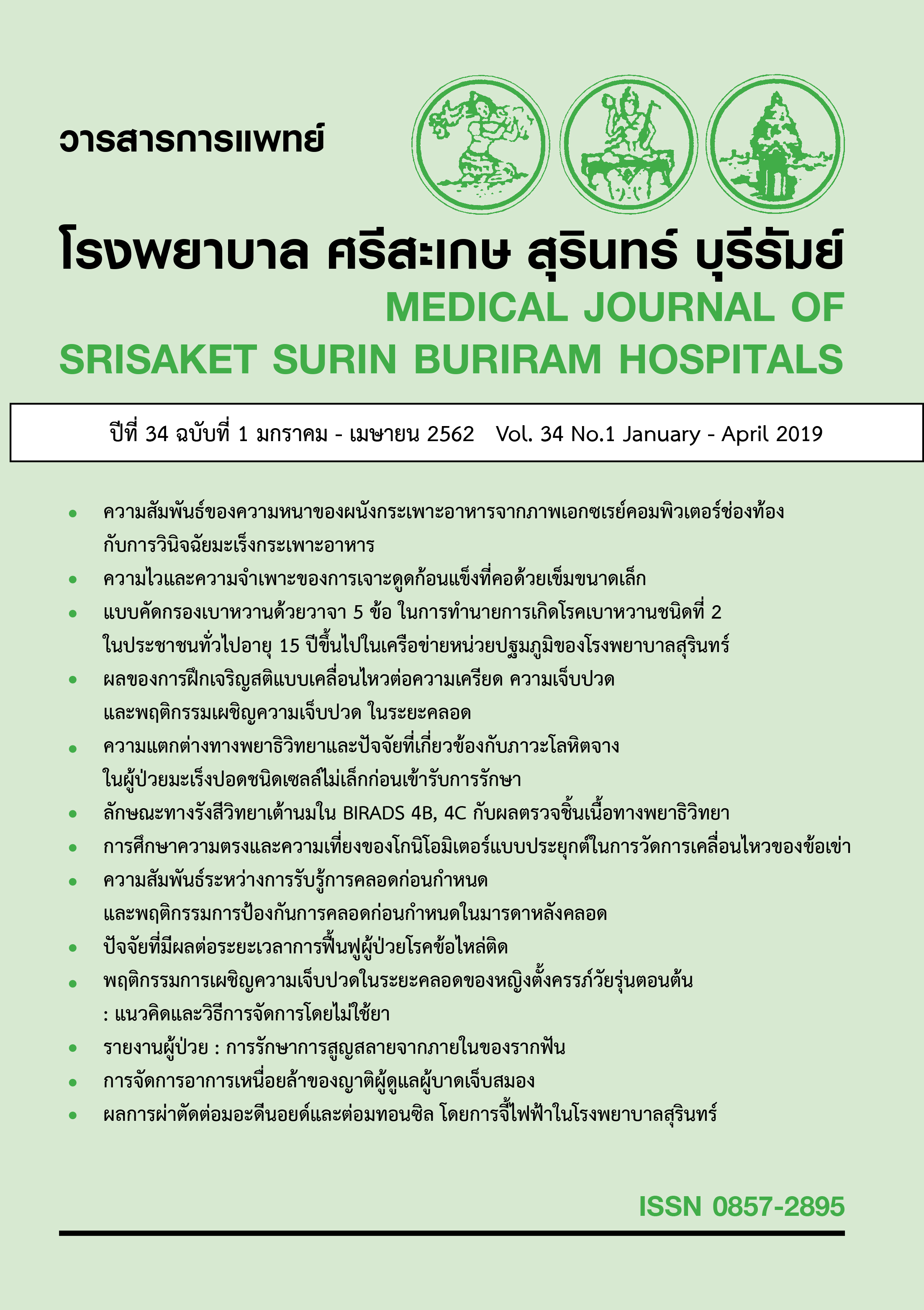ลักษณะทางรังสีวิทยาเต้านมใน BIRADS 4B, 4C กับผลตรวจชิ้นเนื้อทางพยาธิวิทยา
Main Article Content
บทคัดย่อ
บทนำ: การศึกษาครั้งนี้มีวัตถุประสงค์เพื่อดูความสัมพันธ์ของลักษณะทางรังสีวิทยาเต้านมระหว่าง Breast Imaging Reporting And Data System (BIRADS) 4B และ 4C และผลตรวจชิ้นเนื้อทางพยาธิวิทยา
วิธีการศึกษา: เป็นการศึกษาแบบ retrospective study เก็บข้อมูลผู้ป่วยที่ได้รับการทำการตรวจเต้านมด้วยวิธี แมมโมแกรม (Mammography) และอัลตราซาวด์ (Ultrasound) เต้านมโดยรายงานผลการตรวจตาม Breast Imaging Reporting And Data System (BIRADS) ในโรงพยาบาลบุรีรัมย์ ตั้งแต่ 1 มกราคม พ.ศ.2560 ถึง 31 ธันวาคม พ.ศ.2560 ที่รายงานผล BIRADS 4B และ BIRADS 4C และได้รับการตรวจชิ้นเนื้อทางพยาธิวิทยา โดย excisional biopsy
ผลการศึกษา: ผู้ป่วยที่รายงานผลเป็น BIRADS 4B และ BIRADS 4C 112 ราย อายุเฉลี่ย 52.5 ปีในผู้ป่วย BIRADS 4B มีผลทางพยาธิวิทยาเป็น benign 34 ราย (ร้อยละ 61.8) และ malignancy 14 ราย (ร้อยละ 24.6) (p-value 0.000) BIRADS 4C ผลทางพยาธิวิทยาเป็น malignancy 43 ราย (ร้อยละ 75.4) และ benign 21 ราย (ร้อยละ 38.2) (p-value 0.000) แมมโมแกรมและอัลตราซาวด์ ที่มีลักษณะที่บ่งชี้ไปทางรอยโรคที่ไม่ใช่มะเร็ง (benign lesion) มากกว่า รอยโรคมะเร็ง (malignant lesion) คือ oval shape และ non calcified (p-value 0.029 และ 0.022 ตามลำดับ) และมีลักษณะที่บ่งชี้ไปทาง malignant lesion มากกว่า benign lesion คือ Irregular shape fine pleomorphic calcification และ axillary lymphadenopathy (p-value 0.037, 0.000 และ 0.013 ตามลำดับ)
สรุป: BIRADS 4C มีโอกาสพบมะเร็งเต้านมสูงกว่าเมื่อเทียบกับ BIRADS 4B โดยเฉพาะอย่างยิ่งถ้าพบลักษณะ Irregular shape, fine pleomorphic calcification และ axillary lymphadenopathy ดังนั้น ควรเพิ่มความระวังในการตรวจหากพบ irregular shape fine pleomorphic calcification และ axillary lymphadenopathy แต่ผลทางพยาธิวิทยาเป็น benign lesion
คำสำคัญ: แมมโมแกรม อัลตราซาวด์ BIRADS รอยโรคเต้านม
Article Details
References
2. Siegel RL, Miller KD, Jemal A. Cancer Statistics, 2017. CA Cancer J Clin 2017;67(1):7-30.
3. Jørgensen KJ, Kalager M, Barratt A, Baines C, Zahl PH, Brodersen J, et al. Overview of guidelines on breast screening: Why recommendations differ and what to do about it. Breast 2017;31:261-9.
4. Sitt JC, Lui CY, Sinn LH, Fong JC. Understanding breast cancer screening-past, present, and future. Hong Kong Med J 2018;24(2):166-74.
5. Peairs KS, Choi Y, Stewart RW, Sateia HF. Screening for breast cancer. Semin Oncol 2017;44(1):60-72.
6. Spak DA, Plaxco JS, Santiago L, Dryden MJ, Dogan BE. BI-RADS® fifth edition: A summary of changes. Diagn Interv Imaging 2017;98(3):179-90.
7. Bent CK, Bassett LW, D'Orsi CJ, Sayre JW. The positive predictive value of BI-RADS microcalcification descriptors and final assessment categories. AJR Am J Roentgenol 2010;194(5):1378-83.
8. Leblebici IM, Bozkurt S, Eren TT, Ozemir IA, Sagiroglu J, Alimoglu O. Comparison of clinicopathological findings among patients whose mammography results were classified as category 4 subgroups of the BI-RADS. North Clin Istanb 2014;1(1):1-5.
9. Youk JH, Kim EK, Kim MJ, Lee JY, Oh KK. Missed breast cancers at US-guided core needle biopsy: how to reduce them. Radiographics 2007;27(1):79-94.
10. Parikh J, Tickman R. Image-guided tissue sampling: where radiology meets pathology. Breast J 2005;11(6):403-9.
11. Liberman L. Percutaneous image-guided core breast biopsy. Radiol Clin North Am 2002;40(3):483-500, vi.
12. Wiratkapun C, Bunyapaiboonsri W, Wibulpolprasert B, Lertsithichai P. Biopsy rate and positive predictive value for breast cancer in BI-RADS category 4 breast lesions. J Med Assoc Thai 2010;93(7):830-7.
13. Levy L, Suissa M, Chiche JF, Teman G, Martin B. BIRADS ultrasonography. Eur J Radiol 2007;61(2):202-11.
14. Elverici E, Barça AN, Aktaş H, Özsoy A, Zengin B, Çavuşoğlu M, et al. Nonpalpable BI-RADS 4 breast lesions: sonographic findings and pathology correlation. Diagn Interv Radiol 2015;21(3):189-94.
15. Lee HJ, Kim EK, Kim MJ, Youk JH, Lee JY, Kang DR, et al. Observer variability of Breast Imaging Reporting and Data System (BI-RADS) for breast ultrasound. Eur J Radiol 2008;65(2):293-8.
16. Costantini M, Belli P, Ierardi C, Franceschini G, La Torre G, Bonomo L. Solid breast mass characterisation: use of the sonographic BI-RADS classification. Radiol Med 2007;112(6):877-94.
17. Atasoy MM, Tasali N, Çubuk R, Narin B, Deveci U, Yener N, et al. Vacuum-assisted stereotactic biopsy for isolated BI-RADS 4 microcalcifications: evaluation with histopathology and midterm follow-up results. Diagn Interv Radiol 2015;21(1):22-7.
18. Sickles EA. Breast calcifications: mammographic evaluation. Radiology 1986;160(2):289-93.
19. Scaranelo AM, Eiada R, Bukhanov K, Crystal P. Evaluation of breast amorphous calcifications by a computer-aided detection system in full-field digital mammography. Br J Radiol 2012;85(1013):517-22.
20. Nalawade YV. Evaluation of breast calcifications. Indian J Radiol Imaging 2009;19(4):282-6.
21. Kim MJ, Kim D, Jung W, Koo JS. Histological analysis of benign breast imaging reporting and data system categories 4c and 5 breast lesions in imaging study. Yonsei Med J 2012;53(6):1203-10.
22. Walsh R, Kornguth PJ, Soo MS, Bentley R, DeLong DM. Axillary lymph nodes: mammographic, pathologic, and clinical correlation. AJR Am J Roentgenol 1997;168(1):33-8.
23. Görkem SB, O'Connell AM. Abnormal axillary lymph nodes on negative mammograms: causes other than breast cancer. Diagn Interv Radiol 2012;18(5):473-9.

